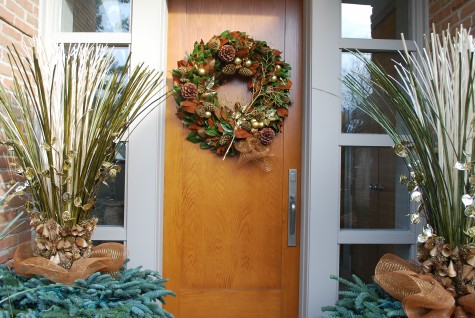 A client whose exuberant husband was campaigning for more in the way of holiday decorations outdoors had only one request. All natural materials, please. Garlands comprised of fresh fir, grapevine, tallow berries, pine cones and magnolia are as natural as could be, and fit right into an existing landscape. All of the materials came originally from the landscape. The textures, colors and forms are easy on the eye, meaning is just about impossible to over do a natural look. I was not worried that my client would feel overwhelmed. I was sure it would just feel warm.
A client whose exuberant husband was campaigning for more in the way of holiday decorations outdoors had only one request. All natural materials, please. Garlands comprised of fresh fir, grapevine, tallow berries, pine cones and magnolia are as natural as could be, and fit right into an existing landscape. All of the materials came originally from the landscape. The textures, colors and forms are easy on the eye, meaning is just about impossible to over do a natural look. I was not worried that my client would feel overwhelmed. I was sure it would just feel warm.
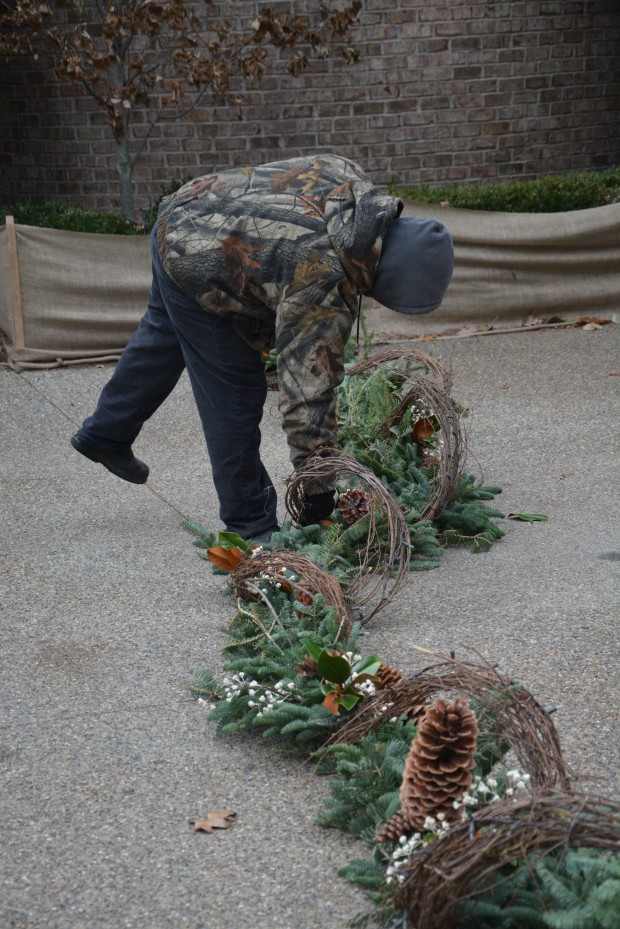 Properly judging the volume and scale needed can make a world of difference in the result. For an entrance garland, big sugar cones have much more impact from the ground than white pine cones. Magnolia leaves read well from a distance, as they are large. White tallow berries stand out, as everything white in the garden does. Rolls of grapevine come spring loaded with volume. What might look over scaled on the ground will look just right, hung high on the wall of a building. To be sure we would have enough volume, we had 2 25 foot lengths ready to hang.
Properly judging the volume and scale needed can make a world of difference in the result. For an entrance garland, big sugar cones have much more impact from the ground than white pine cones. Magnolia leaves read well from a distance, as they are large. White tallow berries stand out, as everything white in the garden does. Rolls of grapevine come spring loaded with volume. What might look over scaled on the ground will look just right, hung high on the wall of a building. To be sure we would have enough volume, we had 2 25 foot lengths ready to hang.
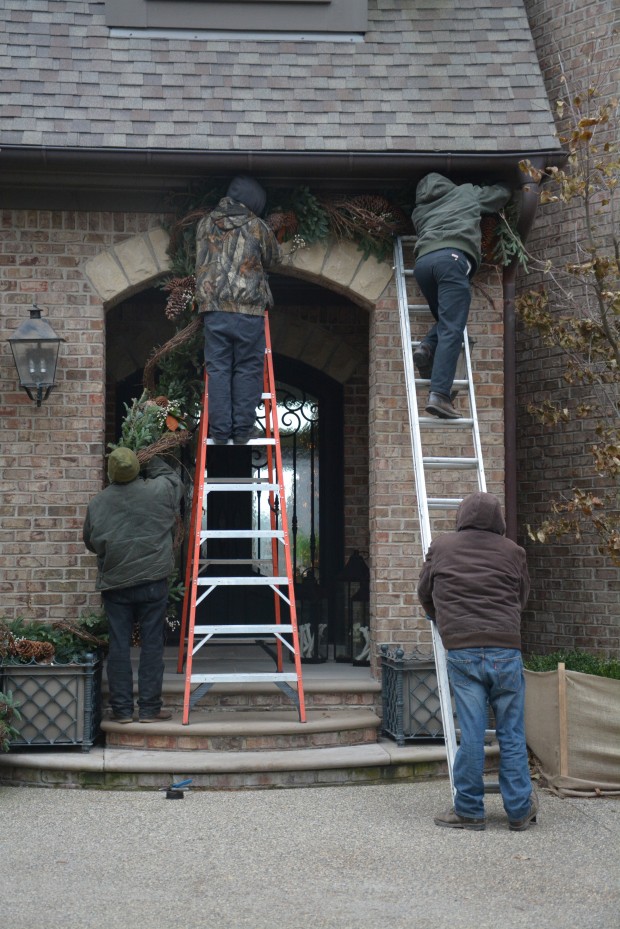 The first garland was attached from the right top corner of the front porch. The first 11 feet would be attached at frequent intervals across the width of the existing fascia board, to the left. The last 14 feet would drape down the left side of the porch.
The first garland was attached from the right top corner of the front porch. The first 11 feet would be attached at frequent intervals across the width of the existing fascia board, to the left. The last 14 feet would drape down the left side of the porch.
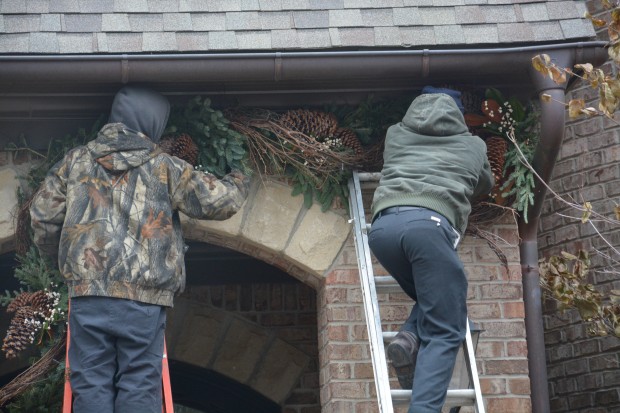 Making sure a garland is firmly attached is a must. I have no idea how much this garland weighs, but the last thing you want is garland sagging in the wind and snow.
Making sure a garland is firmly attached is a must. I have no idea how much this garland weighs, but the last thing you want is garland sagging in the wind and snow.
 Having multiple points to attach the garland means you have the ability to place it exactly as you wish. For this porch, hanging the garland straight across and parallel to the ground would leave the view of the stone arch on the wall intact. Multiple points of attachment means the weight is spread out. Outwitting gravity just takes a little more time and care. It is easier to swag a big garland. The weight and gravity will see that your loops look graceful. But some architecture calls for a clean and simple look. A swag here would run counter to the lines established by the architecture.
Having multiple points to attach the garland means you have the ability to place it exactly as you wish. For this porch, hanging the garland straight across and parallel to the ground would leave the view of the stone arch on the wall intact. Multiple points of attachment means the weight is spread out. Outwitting gravity just takes a little more time and care. It is easier to swag a big garland. The weight and gravity will see that your loops look graceful. But some architecture calls for a clean and simple look. A swag here would run counter to the lines established by the architecture.
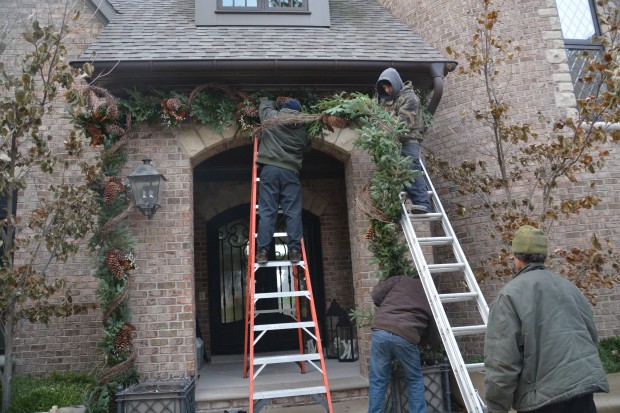 Garland 2 was attached at the top left corner, and hung from the left all the way to the right side. This means there is a double thickness of garland above the door, and a single thickness down each side. A porch of this size calls for a substantial garland, hung outside the coach lights. The garland is a frame for the porch, and will not interfere with any coming and going.
Garland 2 was attached at the top left corner, and hung from the left all the way to the right side. This means there is a double thickness of garland above the door, and a single thickness down each side. A porch of this size calls for a substantial garland, hung outside the coach lights. The garland is a frame for the porch, and will not interfere with any coming and going.
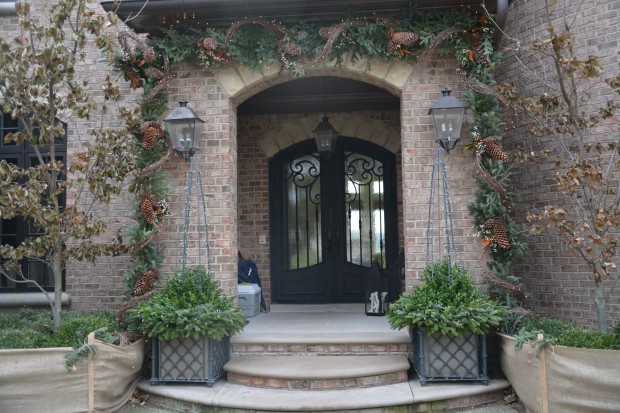 We did run brown corded lights all along the grapevine. This will help to illuminate it at night. All you can see of the lighting in this picture are the light bulbs. The brown cords up high blend invisibly into the grapevine. The overall look of the garland is appropriate to the size of the porch, and looks very warm and inviting to my eye. The containers are simple. A roughly spherical shape of boxwood in the center is surrounded by silver fir. The topiary forms are strung with lights that describes their shape. There are garland lights tucked into the greens.
We did run brown corded lights all along the grapevine. This will help to illuminate it at night. All you can see of the lighting in this picture are the light bulbs. The brown cords up high blend invisibly into the grapevine. The overall look of the garland is appropriate to the size of the porch, and looks very warm and inviting to my eye. The containers are simple. A roughly spherical shape of boxwood in the center is surrounded by silver fir. The topiary forms are strung with lights that describes their shape. There are garland lights tucked into the greens.
 A pair of large windows in the front are faced down with steel boxes from Branch. The boxes were made wider than the window, and have a subtle bow front. The centerpiece from the fall planting was augmented with 2 additional pieces of the same material. These were added to the left and the right of the original centerpiece. The front 2/3rds box is stuffed with a mix of silver fir and boxwood. The rear 1/3rd is all boxwood. The boxes have lights near the centerpiece assembly, and in the greens.
A pair of large windows in the front are faced down with steel boxes from Branch. The boxes were made wider than the window, and have a subtle bow front. The centerpiece from the fall planting was augmented with 2 additional pieces of the same material. These were added to the left and the right of the original centerpiece. The front 2/3rds box is stuffed with a mix of silver fir and boxwood. The rear 1/3rd is all boxwood. The boxes have lights near the centerpiece assembly, and in the greens.
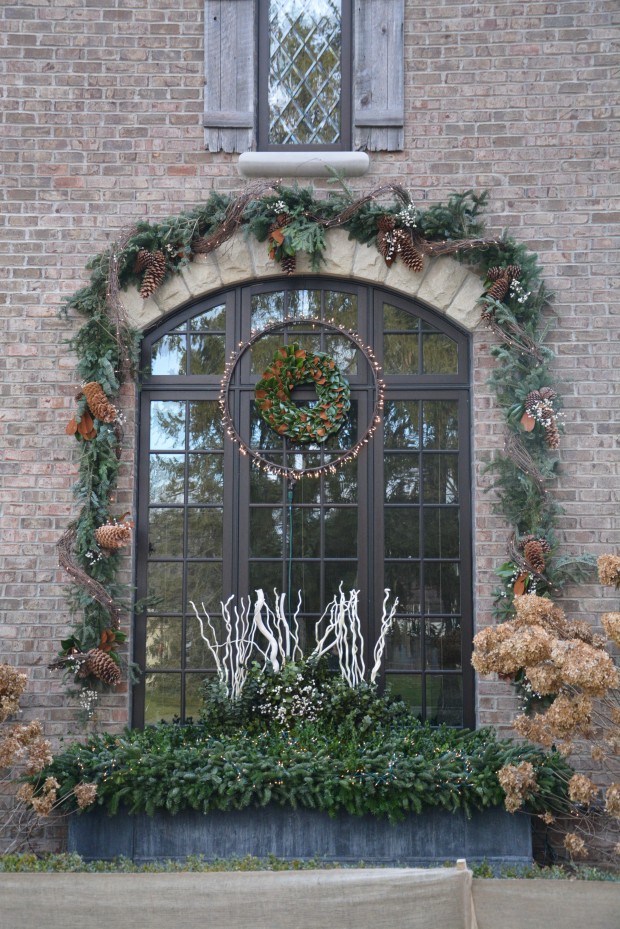 Every year we hang one of Rob’s light rings in the window, with a plain magnolia wreath in the center. We wire the wreath to the ring in four places, so it stays put even on windy days. This year we added a garland over the top. A single garland is centered over the window, and hung high enough so the stone arch is still visible. The garland stops 16″ above the box, so as not to interfere with the shape established in the container. This is a warm winter look, with a splash of holiday.
Every year we hang one of Rob’s light rings in the window, with a plain magnolia wreath in the center. We wire the wreath to the ring in four places, so it stays put even on windy days. This year we added a garland over the top. A single garland is centered over the window, and hung high enough so the stone arch is still visible. The garland stops 16″ above the box, so as not to interfere with the shape established in the container. This is a warm winter look, with a splash of holiday.
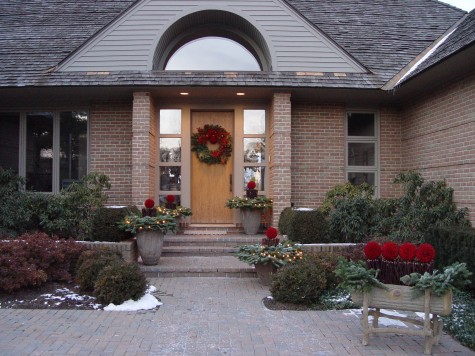
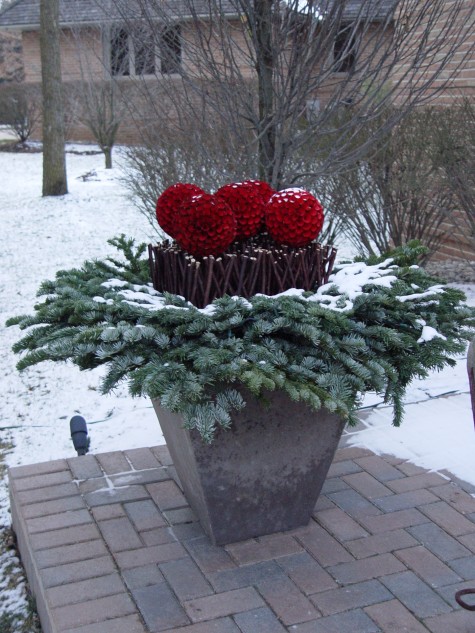
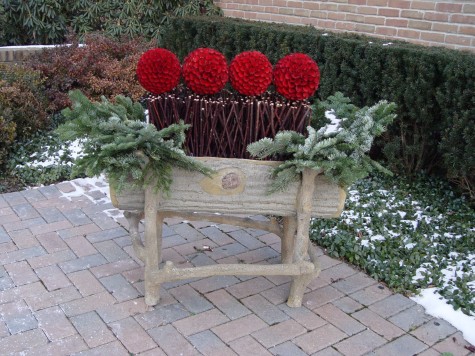
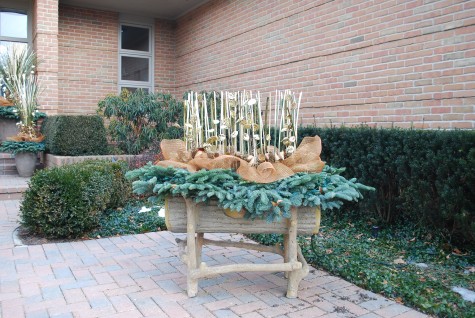
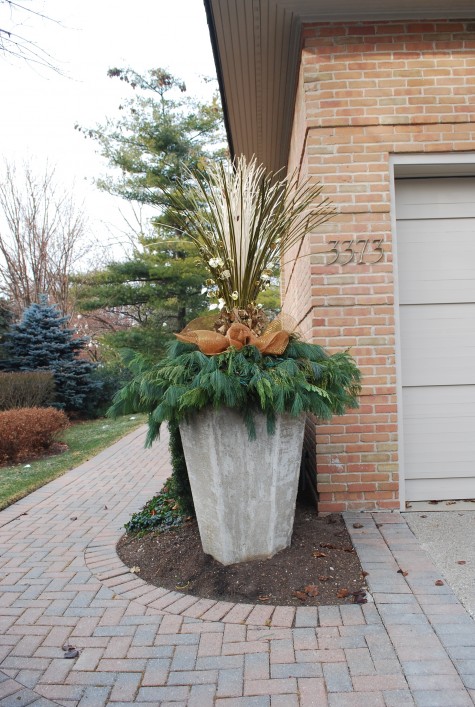 The walk to the front door is kept company by an overscaled concrete planter of our manufacture. The stick stack frames the house numbers on the wall. A walk that does not immediately appear to lead anywhere needs a strong signal-come this way, please. How the weather works on these twig stacks is a hand over which I have no control. They gracefully open and bend with the weather in a way I could not duplicate. Two parts a client, two parts nature, and one part from me-looking good.
The walk to the front door is kept company by an overscaled concrete planter of our manufacture. The stick stack frames the house numbers on the wall. A walk that does not immediately appear to lead anywhere needs a strong signal-come this way, please. How the weather works on these twig stacks is a hand over which I have no control. They gracefully open and bend with the weather in a way I could not duplicate. Two parts a client, two parts nature, and one part from me-looking good.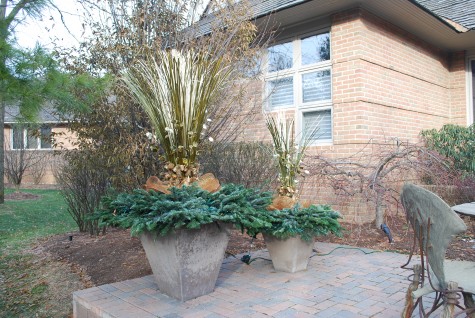 There is ample room on the terrace for this pair of Francesca squares. Like all of the other pots, these squares are sparingly lit. It is less than two weeks to the shortest day of our year.
There is ample room on the terrace for this pair of Francesca squares. Like all of the other pots, these squares are sparingly lit. It is less than two weeks to the shortest day of our year.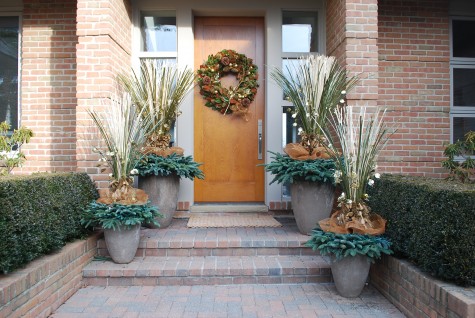 Four Francesca flutes make for a striking holiday garden at the front door. This Italian terra cotta is tough enough to withstand our vile winters; the ability to have terra cotta outside at this time of year is cause for celebration in and of itself. Some contemporary expression is hard on the eyes, and lacking human softening; this can border on cold. This is no time of year to add cold to the cold we already have. I so like how she chose materials so soft in color, and so subtle in contrast-it was up to me to put them together in a contemporary way. The interplay of contemporary and traditional elements is lively.
Four Francesca flutes make for a striking holiday garden at the front door. This Italian terra cotta is tough enough to withstand our vile winters; the ability to have terra cotta outside at this time of year is cause for celebration in and of itself. Some contemporary expression is hard on the eyes, and lacking human softening; this can border on cold. This is no time of year to add cold to the cold we already have. I so like how she chose materials so soft in color, and so subtle in contrast-it was up to me to put them together in a contemporary way. The interplay of contemporary and traditional elements is lively. 